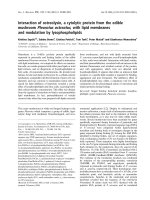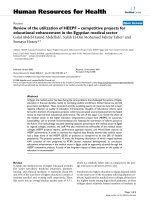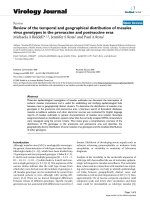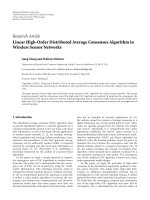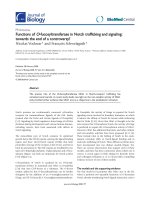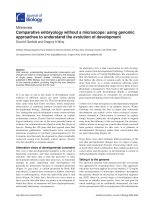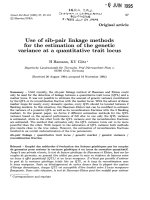Báo cáo sinh học: "Review of “Bioinformatics: A Computing Perspective” edited by Shuba Gopal, Anne Haake, Rhys Price Jones and Paul Tymann" doc
Bạn đang xem bản rút gọn của tài liệu. Xem và tải ngay bản đầy đủ của tài liệu tại đây (169.05 KB, 2 trang )
BioMed Central
Page 1 of 2
(page number not for citation purposes)
Algorithms for Molecular Biology
Open Access
Book report
Review of “Bioinformatics: A Computing Perspective” edited by
Shuba Gopal, Anne Haake, Rhys Price Jones and Paul Tymann
Dae-Won Kim and Hong-Seog Park*
Address: Genome Research Center, Korea Research Institute of Bioscience and Biotechnology, Daejeon 305-806, Korea
Email: Dae-Won Kim - ; Hong-Seog Park* -
* Corresponding author
Book details
Gopal S, Haake A, Jones RP, Tymann P: Bioinformatics: A
Computing Perspective McGraw-Hill; 2009:460. Hardcover,
ISBN 978-007-126390-0
Overview
The passion of scientists in interdisciplinary fields to
understand living beings gave rise to the field of bioinfor-
matics. These scientists employ a number of methodolo-
gies and tools to deal with massive amounts of biological
data. 'Bioinformatics: A Computing Perspective' is a com-
prehensive compilation of biological basics, computa-
tional methods, and modern approaches for resolving
biological problems well suited to individuals with back-
ground education in computer science. In addition, this
book provides long-running examples and discussions
throughout the text to help students understand complex
biological ideas.
Contents
This book consists of nine chapters. The first chapter pro-
vides a history of scientific works and a definition of bio-
informatics. Topics include the organization and roles of
a bioinformatics team and the challenges of computa-
tional algorithms in molecular biology. Chapter 2 illus-
trates some overall basics of biology, including cellular
organization and complexity, evolution, and how the lan-
guage of cells is encoded at various steps through DNA,
RNA and protein. This chapter also provides a description
of the management of genetic data, including replication
and verification of DNA. Chapter 3 deals with fundamen-
tal wet lab techniques, describing the principles of hybrid-
ization, cDNA synthesis, DNA sequencing methods and
proteomics techniques. This chapter emphasizes the
importance of development of appropriate computa-
tional approaches to working with biological data to pro-
vide an understanding and characterization of those data.
Chapters 4 and 5 provide a broad overview of fragment
assembly, aimed especially at answering two main ques-
tions: What is the problem of biological sequence assem-
bly? and What are the various computational approaches
used for sequence alignment? Chapter 4 addresses the
issue of the nature of genome sequences. It provides the
reader with a basic example and simple pattern matching
and graph algorithms for solving the sample problem.
Chapter 5 provides descriptions of more extensive and
advanced alignment algorithms for more exact similarity
detection, such as Deterministic finite-state automata
(DFAs), the Needleman-Wunsch algorithm, and the
Smith-Waterman algorithm. This chapter also deals with
evolutionary and heuristic approaches, including point
accepted mutation (PAM).
Chapter 6 introduces the concept of evolution and com-
putational methods for the discovery of evolutionary rela-
tionships based on the tree of life. This chapter offers a
detailed introduction regarding how best to build phylog-
enies, including discussion of neighbor joining, maxi-
mum likelihood and maximum parsimony approaches.
This chapter may be of particular interest to biological sci-
entists who conduct evolutionary studies, since the mod-
els discussed in this chapter are commonly used in
analysis of the prehistory of an organism.
Published: 24 June 2009
Algorithms for Molecular Biology 2009, 4:9 doi:10.1186/1748-7188-4-9
Received: 10 June 2009
Accepted: 24 June 2009
This article is available from: />© 2009 Kim and Park; licensee BioMed Central Ltd.
This is an Open Access article distributed under the terms of the Creative Commons Attribution License ( />),
which permits unrestricted use, distribution, and reproduction in any medium, provided the original work is properly cited.
Publish with BioMed Central and every
scientist can read your work free of charge
"BioMed Central will be the most significant development for
disseminating the results of biomedical research in our lifetime."
Sir Paul Nurse, Cancer Research UK
Your research papers will be:
available free of charge to the entire biomedical community
peer reviewed and published immediately upon acceptance
cited in PubMed and archived on PubMed Central
yours — you keep the copyright
Submit your manuscript here:
/>BioMedcentral
Algorithms for Molecular Biology 2009, 4:9 />Page 2 of 2
(page number not for citation purposes)
Chapters 7 and 8 provide a discussion of the principle of
decipherment of genome sequences. Chapter 7 focuses on
approaches for analyzing genomic sequences to identify
biologically meaningful patterns. This chapter provides
mathematical methods for assessing consensus sequences
using position-specific weight matrices (PSWM) and find-
ing gene structure and open reading frames (ORF) via
Hidden Markov Models (HMM). Chapter 8 briefly intro-
duces molecular mechanisms and provides a flood of bio-
logical data. Further, it deals with the analysis of
microarray expression data for understanding compli-
cated phenomena in biology. This chapter provides a
description of various array-based technologies and a dis-
cussion of the procedures and the computational
approaches to the analysis of gene expression data,
including gene filtering, scaling, normalization and trans-
formation. In addition, it includes worked examples and
a discussion of clustering algorithms (Hierarchical cluster-
ing, K-means clustering, self-organizing map) and classifi-
cation methods (genetic algorithms, support vector
machines).
The final chapter touches on several different issues, many
of which are cutting edge in the field of bioinformatics. It
provides a brief but lucid treatment of the visualization of
complex biological datasets, non-coding RNA function
prediction, drug discovery through protein structure, the
mapping of complex diseases, and systems biology.
Summary
Bioinformatics is a vast multidisciplinary field. Bioinfor-
matics: A Computing Perspective does a good job of compil-
ing the relevant topics about the state of the art and
challenges facing bioinformatics in the field of biology.
This book has several strong points. Although it is consist-
ing of many chapters and subtitles dealing with detailed
computing techniques and experimental methodologies,
a diversity of attempts have been made to bring together
descriptions of bioinformatics, biological basics, detailed
experimental methodologies and computing algorithm
for understanding biological complexes. The style is very
readable, and discusses both the biology and the compu-
tation of every topic presented. In particular, this text
places emphasis on practical skills involved in analyzing
genes and proteins, extracting sequence data, and identi-
fying genes and proteins implicated in disease by provid-
ing ample illustrative examples and extensive java codes.
Many algorithms are built up in steps, showing how suc-
cessive insights from both computation and biology can
make existing techniques work better. Consequently, this
book is inspiring readers to design the breakthrough com-
putational approaches and algorithms that will provide
novel and valuable insights into biological phenomena.
In summary, this book provides an excellent resource for
those initiating a study of biology based on computer sci-
ence and provides interesting facts to give life to lectures
on this topic. Most of the topics discussed show a fascinat-
ing snapshot of current progress in bioinformatics using
advanced technologies. Moreover, the examples in this
book help provide an understanding of the complicated
algorithms described.
Competing interests
The authors declare that they have no competing interests.
Authors' contributions
DK: conception, drafting and final approval of the manu-
script. HP: drafting and final approval of the manuscript.
